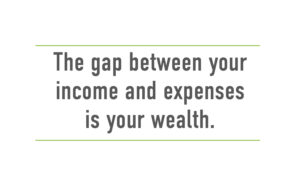The importance of “financial wellness” has increased in popularity in recent years. According to the University of San Diego, “Financial wellness is an on-going process and combination of increasing awareness of your current financial state, strengthening your knowledge of Financial Literacy, making well-informed decisions, and taking intentional and mindful steps towards achieving a healthy financial well-being”. Think about maintaining a physically healthy lifestyle through diet and exercise. There is a goal to live a healthy life, a basic framework of principles, and an action plan to follow. While the principles are universal, the action plan can differ for everyone. The same applies to financial health, but financial goals can be hard to define and the framework confusing or unknown (we are taught to eat our veggies, but not to open an IRA). A basic framework of principles related to personal cash flow management can be applied to an action plan that works for you.
Cash Flow & Budgeting:
“Don’t go to Starbucks so much,” often comes to mind when thinking about budgeting. While managing spending is important, the real goal is to manage cash flow today and set a foundation to accumulate wealth. By focusing on this goal, less time can be spent on tedious expense tracking, allowing for more time spent on setting financial milestones and tailoring behavior to reach them. A practical understanding of Cash Flow Management will let you stress less about money, leaving more room to just enjoy life!
Cash flow is the concept that everyone has a certain amount of money that flows in (inflows) and flows out (outflows). The majority of inflows typically will be income from a job, but can also come from investments, gifts, or any cash you can spend, save, or invest. Outflows can be broken down into three categories: Necessary (the “have to’s”), Discretionary (the “want to’s”), and your Savings (“paying yourself”). Everyone, from a college grad to Jeff Bezos, has inflows and outflows. Cash Flow Management is the ability to know your inflows and outflows and establish guardrails for a fiscally responsible life. Let’s consider the basic principles and how you can apply them:

Cash Flow Principles:
1. Spend less than you make: Simple, yet oftentimes challenging. Inflows should never be less than outflows on a regular basis. No matter your income, if expenses exceed income on a regular basis, you are headed for trouble. Businesses that spend more than they earn eventually go bust. The same is true for people. You might be able to bridge the gap with debt, but that is a coverup to a larger problem. After all, if you cannot meet your current expenses with today’s inflows, how can you expect to cover the additional interest expense?
2. Pay Yourself First: A certain amount of money should be “spent” on yourself through monthly contributions to a savings and/or investing account. This is a key guardrail that continuously improves your finances. The gap between your income and expenses is your wealth – prioritize it!

3. Pay bills in full: Credit cards make it easy to securely pay bills and buy the things we want or need. The balance should be paid in full every month – end of story! Any balance not fully paid will incur interest, which is an unnecessary outflow.
Applying the Principles:
1. Keep it Simple: The majority of people (even families) need only one checking account. A checking account serves an important purpose – inflows get deposited, and outflows are paid. It is the core of your financial plumbing system – flowing money in, out, and redirecting it to your wealth building accounts. Don’t over complicate it.
2. Get Honest: Review the last 3 bank statements and credit card statements. Write down your monthly inflows and your outflows between Necessary, Discretionary, and Savings. It won’t be the same month to month, but you must know the average inflows and break down your spending between the “have to’s” and the “want to’s”. If the difference between inflows and spending is positive, that’s great – start saving! If the difference is negative, decrease your discretionary outflows, increase your inflows, or some combination of both.*
3. Automatic Savings: Open a savings account and link to your checking account. Deposit something (anything!) into that account and set up an automatic monthly transfer from your checking to your savings. More important than the amount that you contribute is just doing it. The habit of automated savings will pay huge dividends (literally!). If you already have a fully funded Emergency Fund, start contributions to an investment account (IRA, 401K, Brokerage). Invest early, and invest often!
4. Automatic Payments: All credit cards will allow you to pay the entire balance automatically by the due date. Enable this option! The tyranny of credit card debt is crippling, so when it comes to rolling a credit card balance, just say no.
5. Monitor Progress: You can use many free online budgeting apps. You can also simply start tracking the balance in your checking, savings, and investment account at the end of every month. If the balance is steadily rising over time, congratulations! If balances are decreasing over time, go back to #2 (Get Honest) and figure out what can be done to cut discretionary outflows or increase inflows. If your balances are staying flat, great – now revisit the “PYF” concept and start accumulating wealth.*
By following an action plan that puts principles into action, you will find budgeting, saving, and cash management quite manageable. There is an investment of time initially, but the benefits are worth it. Like any good habit, it might be hard to start, but commitment and repetition are key to a successful outcome.
*For a free account tracking template or free cash flow template email commoncents@northbrookfinancial.com.
_
Elliot Pepper, CPA, CFP®, MST is Co-Founder of Northbrook Financial, a Financial Planning, Tax, and Investment Management Firm. He has developed and continues to teach a popular Financial Literacy course for high school students.

 Common Cents
Common Cents